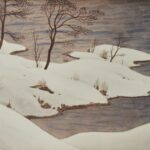Oskar Bergman
Biography
Oskar Bergman was born in Stockholm in 1879 into a modest family. At home, his artistic talent was not immediately recognized, so he educated himself with occasional drawing lessons from a friend of his mother. When his father died suddenly in 1888, the family’s finances became strained, and by age thirteen, Bergman was working as a courier for a tailor. During weekdays, he made deliveries around Stockholm; on Sundays, he visited the National Museum, where he was particularly drawn to the works of Swedish Romantic painters such as Marcus Larson (1825–1864) and Nils Blommér (1816–1853). In this way, he developed a self-taught foundation in art history.
At sixteen, he entered the Technical School and studied under Anders Forsberg (1871–1914). He did not plan to attend the Academy; instead, using his small savings, he traveled in Europe to study museums and private collections. In 1901, he visited Germany, where, besides admiring the Old Masters, he discovered the work of Caspar David Friedrich, whose treatment of nature—free from the excesses of Romantic fervor—fascinated Bergman.
On returning to Sweden, Bergman met the banker and collector Ernest Jacques Thiel (1859–1947), who encouraged him by purchasing one of his drawings. Thiel introduced him to his artists’ retreat in Saltsjöbaden. In 1904, through Thiel and his wife, Bergman met the Symbolist painter Armand Point (1861–1932), who was sufficiently impressed by his work to suggest that Bergman come to Florence to study under him. Thiel financed this trip, which included visits to Berlin, Munich, Verona, and Rome. In Florence, Bergman presented the drawings and notes he had made, and Point agreed to give him free instruction.
During his apprenticeship with Point, Bergman discovered the art of Arnold Böcklin, whose influence strongly marked his work in the early twentieth century, though it gradually lessened over time without ever disappearing entirely. Returning to Sweden in 1906, Bergman co-organized an exhibition with the sculptor Peter David Edstrom (1873–1938) and painter Ivar Arosenius (1878–1909), which served as his first major public showcase.
In 1909, the modernist group known as “The 1909 Men” caused scandal by introducing Expressionist and Fauvist innovations to Swedish art; in contrast, Bergman’s serene landscapes were perceived by critics and the public as exemplars of traditional Swedish painting. This distinction nonetheless inaugurated a fruitful phase in his career; he participated in numerous national and international exhibitions. In 1917, the National Museum in Stockholm purchased his watercolor By the Sea.
After 1930, as avant-garde styles became more widely accepted and no longer shocking, Bergman remained unmoved; he did not adopt the new expressive freedoms but continued to pursue his individual artistic research. Each day, after walking in nature, he would work in his studio—often simultaneously on two watercolors. His perseverance and consistent devotion to depicting the Swedish landscape made him a figure of national importance.
In 1957, he was awarded the Egron Lundgren Medal by King Gustav VI Adolf. When Oskar Bergman died in 1963, aged 84, he was recognized as one of Sweden’s most celebrated landscape artists.


